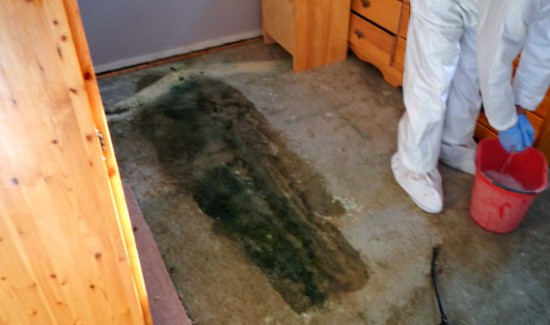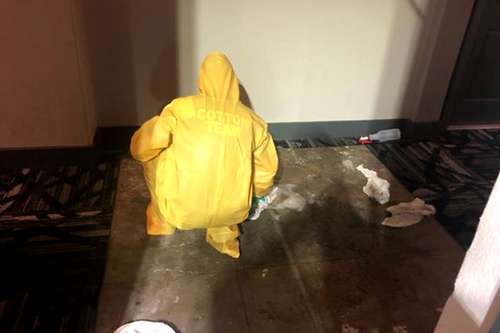Specialist Biohazard Cleanup for Crime Scenes, Injury Incidents, and Polluted Spaces
In the world of professional biohazard clean-up, thorough attention to detail and adherence to safety and security protocols are critical. As we dive right into the complexities of biohazard cleanup for these sensitive environments, a deeper understanding of the obstacles and critical treatments entailed will certainly emerge, dropping light on the vital role of specialist cleaning solutions in recovering safety and peace of mind.

Importance of Biohazard Cleanup
Biohazard cleanup following crime scenes and injury cases is critical for making certain the security of individuals and the environment. When these cases happen, they usually leave a selection of biohazards such as blood, bodily liquids, and various other possibly contagious materials. These substances can nurture hazardous microorganisms like viruses and bacteria, posturing significant wellness dangers otherwise appropriately cleaned up and sanitized.
Specialist biohazard clean-up solutions are trained to handle these unsafe materials securely and successfully. They have the necessary tools, such as personal safety gear and specialized cleaning up representatives, to completely sanitize the impacted locations. By leaving the clean-up to experienced experts, people can prevent direct exposure to damaging pathogens and stop the spread of infectious conditions.
Moreover, appropriate biohazard cleanup is vital for protecting the atmosphere. Inappropriate disposal of biohazardous materials can pollute dirt, water sources, and air, presenting a threat to wildlife and the environment. By following stringent clean-up methods, professionals can make sure that biohazards are securely removed and taken care of according to policies, decreasing the risk of environmental contamination.
Kinds Of Biohazards Encountered
Numerous harmful products frequently come across in criminal offense scenes and injury occurrences present significant health risks if not handled properly. Blood and physical liquids are among the most common biohazards discovered in these situations.
Another sort of biohazard often run into is sharp things like needles, damaged glass, and other items that can create injuries and transfer infections. Chemical risks are likewise a concern, as crime scenes might have compounds like tear gas, pepper spray, or drug production products that need specialized handling and disposal treatments to avoid additional damage.
Additionally, mold and microorganisms growth can occur precede where disintegration or extended exposure to wetness has taken place. These microbes can launch toxic substances and allergens right into the air, presenting breathing risks to those revealed. Generally, biohazard cleanup specialists should be well-equipped and skilled to successfully deal with these various sorts of dangerous products to make sure the safety of themselves and others.
Equipment and Protective Equipment
When resolving the vital task of taking care of biohazards encountered in criminal offense scenes and injury events, the use of proper equipment and safety equipment is paramount to making sure the safety and security of individuals included in the clean-up procedure. Individual protective equipment (PPE) such as gloves, coveralls, goggles, and masks are necessary to prevent direct contact with potentially dangerous materials. Respirators are crucial when handling biohazards that may become airborne, safeguarding workers from inhaling harmful bits. Specialized cleansing devices like biohazard anti-bacterials, sharps, and bags containers are needed for the secure collection and disposal of infected products. In addition, sturdy tools such as industrial-grade cleansing representatives, foggers, and ozone generators may be needed to completely sanitize the affected area. Ensuring that all equipment is properly kept, routinely examined, and used according to safety standards is essential in lessening the danger of exposure to biohazards during cleaning procedures.
Clean-up Process and Strategies
Detailed and reliable clean-up of biohazardous products from criminal offense scenes and injury events calls for precise focus to detail and adherence to stringent safety and security protocols. The cleaning process normally involves a number of vital steps. At first, the location should be examined to identify the degree of contamination and the ideal cleaning methods required. Next, all biohazardous products, including blood, bodily liquids, and cells residues, should be carefully removed and taken care of based on regional guidelines.
Adhering to the elimination of biohazardous materials, the affected area goes through a detailed cleansing and sanitation procedure. This action includes the usage of specialized cleaning up agents and equipment to guarantee that all traces of contamination are eliminated. After cleaning, the area undergoes strenuous screening to verify that it is risk-free and totally free of any remaining biohazards.

Decontamination and Disposal Treatments
To ensure detailed decontamination and correct disposal of biohazardous materials, adhering to the meticulous clean-up procedure, certain procedures have to be carefully adhered to with rigorous adherence to safety procedures. Decontamination involves the removal or neutralization of impurities to minimize the threat of exposure and spread of harmful materials. This process usually includes cleansing, disinfecting, and sanitizing the afflicted area utilizing customized tools and EPA-approved chemicals.
As soon as purification is completed, proper disposal of biohazardous materials is crucial to avoid further contamination or damage. Biohazardous waste, such as physical fluids or blood-soaked materials, must be meticulously collected, packaged, and labeled according to regulatory standards. ATP testing. These materials are after that carried to licensed centers for disposal through proper networks, guaranteeing conformity with local, state, and federal laws

Conclusion
Finally, specialist biohazard cleanup is vital for guaranteeing the effective and risk-free elimination of hazardous products from crime scenes, trauma events, and infected rooms. By utilizing specific equipment, protective equipment, and complying with appropriate cleanup processes and strategies, biohazard cleaning teams can properly decontaminate and get rid of of biohazards, lessening the threat of exposure and damage to people and the atmosphere.
As we delve into the complexities of biohazard cleanup for these delicate settings, a deeper understanding of the challenges and essential procedures involved will emerge, shedding light on the vital function of expert cleanup services in restoring safety and security and peace of mind.
Professional biohazard clean-up services are trained to manage these dangerous products securely and mold remediation successfully. By adhering to rigorous cleanup methods, experts can guarantee that biohazards are securely removed and disposed of in conformity with guidelines, minimizing the risk of ecological contamination.
In general, biohazard cleaning specialists must be well-equipped and experienced to properly deal with these different types of unsafe products to guarantee the safety and security of themselves and others.
When dealing with the essential task of dealing with biohazards experienced in criminal activity scenes and injury incidents, the usage of appropriate tools and protective equipment is vital to making sure the safety of people entailed in the clean-up process.